Class 4 English Worksheet Solutions Chapter 10 The Swing
| Table of contents |

|
| Multiple Choice Questions |

|
| Fill in the Blanks |

|
| True or False |

|
| Match the Following |

|
| Crossword Puzzle |

|
Multiple Choice Questions
(Select the correct option)
Q1. What does the poet compare the feeling of swinging to?
(a) Flying
(b) Walking
(c) Running
(d) Climbing
Answer: (a) Flying
Solution: The poet describes swinging as a feeling of flying in the air.
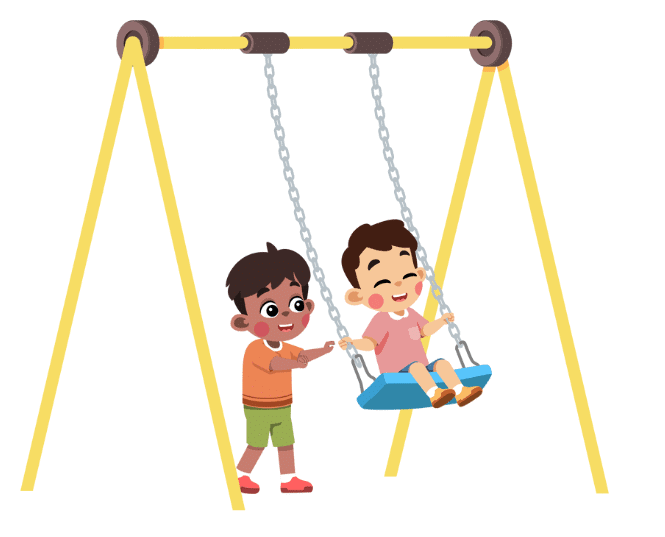
Q2. What does the poet see when the swing goes over the wall?
(a) Animals in the garden
(b) Rivers, trees, and cattle
(c) Clouds and birds
(d) People playing
Answer: (b) Rivers, trees, and cattle
Solution: The poet mentions seeing rivers, trees, and cattle when swinging over the wall.
Q3. How does the poet feel about swinging?
(a) Scared
(b) Excited
(c) Happy
(d) Indifferent
Answer: (c) Happy
Solution: The poet enjoys swinging, as shown by the phrase "I do think it the pleasantest thing."
Q4. Why does the poet describe the air as "blue"?
(a) To suggest it is clear and peaceful
(b) To suggest it is dark and cloudy
(c) To suggest it is warm and sunny
(d) To suggest it is cold
Answer: (a) To suggest it is clear and peaceful
Solution: The poet says "the air is blue" to describe the clear and peaceful sky.
Q5. Where does the poet go when the swing goes up?
(a) To the sky
(b) Over the garden
(c) Over the wall
(d) Over the mountain
Answer: (c) Over the wall
Solution: The poet mentions going "over the wall" as the swing rises.
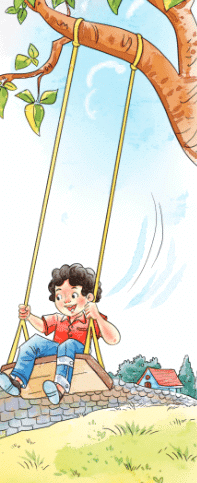
Fill in the Blanks
(Use words from the Word Box)
Word Box: countryside, pleasantest, cattle, garden
The poet enjoys swinging because it is the _______ thing a child can do.
Answer: pleasantest
Solution: The poet calls swinging the "pleasantest thing" a child can do.The poet sees the _______ and trees when swinging high in the air.
Answer: countryside
Solution: The poet sees the wide "countryside" when swinging high.The poet mentions _______ and trees in the landscape while swinging.
Answer: cattle
Solution: The poet sees "cattle" along with rivers and trees.The poet looks down at the _______ and roof as the swing goes down.
Answer: garden
Solution: The poet looks down at the "garden" and roof when the swing goes down.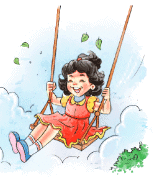
True or False
(Write True or False)
Q1. The poet dislikes swinging.
Answer: False
Solution: The poet enjoys swinging, as shown by the phrase "pleasantest thing."
Q2. The poet describes the air as blue.
Answer: True
Solution: The poet says "the air is blue" to describe the clear, peaceful sky.
Q3. The poet sees animals and plants when swinging.
Answer: True
Solution: The poet mentions seeing rivers, trees, and cattle.
Q4. The poet enjoys the feeling of flying.
Answer: True
Solution: The poet compares the feeling of swinging to flying in the air.
Q5. The poet looks down at the roof and garden when the swing is high.
Answer: False
Solution: The poet looks down at the roof and garden when the swing is going down, not up.
Match the Following
(Draw a line to match each item in Column A with the correct option in Column B)
| Column A | Column B |
|---|---|
| 1. The poet enjoys swinging | A. Trees and rivers |
| 2. The poet sees the garden and roof | B. Flying in the air |
| 3. The poet compares swinging to | C. When the swing goes down |
| 4. The poet sees the countryside | D. The pleasantest thing a child can do |
| 5. The poet feels happy when swinging | E. When the swing goes up |
Answer:
1 → D (The pleasantest thing a child can do)
2 → C (When the swing goes down)
3 → B (Flying in the air)
4 → A (Trees and rivers)
5 → E (When the swing goes up)
Detailed Explanation:
The poet enjoys swinging → The pleasantest thing a child can do: The poet describes swinging as the "pleasantest thing" a child can do.
The poet sees the garden and roof → When the swing goes down: The poet looks down at the garden and roof when the swing is going down.
The poet compares swinging to → Flying in the air: The poet compares the feeling of swinging to flying in the air.
The poet sees the countryside → Trees and rivers: The poet sees rivers, trees, and cattle in the countryside while swinging.
The poet feels happy when swinging → When the swing goes up: The poet expresses happiness and enjoyment when the swing goes up.
Crossword Puzzle
(Solve the crossword using the given clues)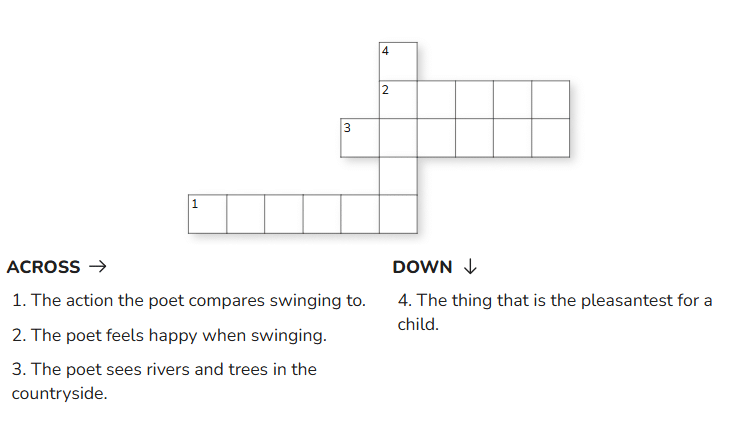
Solution:
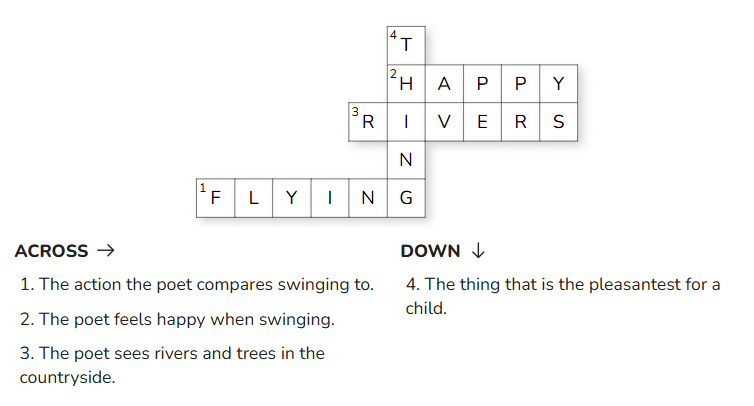
FAQs on Class 4 English Worksheet Solutions Chapter 10 The Swing
| 1. What is the main theme of "The Swing"? |  |
| 2. Who is the author of "The Swing"? |  |
| 3. What emotions does the swing evoke in children according to the article? |  |
| 4. How can "The Swing" be used in teaching children about nature? |  |
| 5. What lessons can children learn from "The Swing"? |  |



















